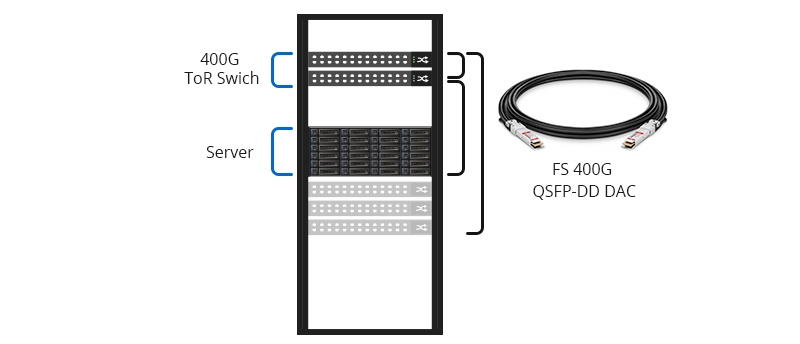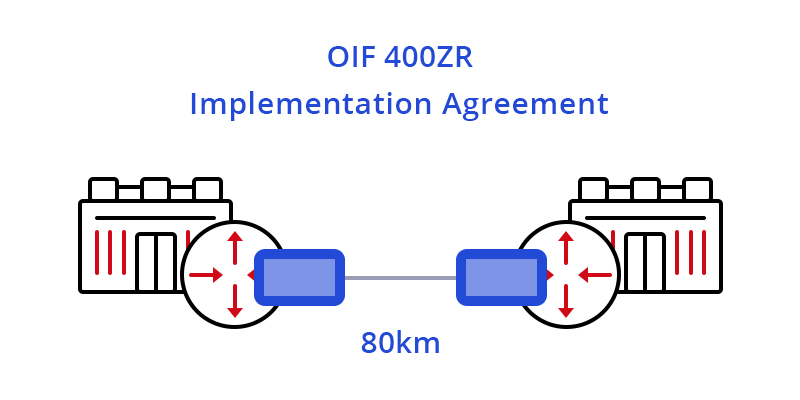QSFP-DD, as the smallest form factor for 400G transceivers, offers industry’s highest bandwidth density while leveraging the backward compatibility to lower-speed QSFP pluggable modules and cables, making it popular among the fiber optic manufacturers. As the newest hot type of optical transceivers in 400G high-speed applications, QSFP-DD is often compared with other modules such as QSFP56, OSFP, CFP8, and COBO. So what are the differences among these optical modules? This post will illustrate them thoroughly.
QSFP-DD Wiki
QSFP-DD (also called QSFP56-DD) stands for Quad Small Form Factor Pluggable Double Density, which is fully compliant with IEEE802.3bs and QSFP-DD MSA standards. The “double density” means the doubling of the number of high-speed electrical interfaces that the module supports compared with a standard QSFP28 module. The data rate of each channel can reach 25Gb/s through NRZ modulation technology, realizing 200G network transmission. Also, the data rate of each channel can reach 50Gb/s by the PAM4 modulation technology, achieving 400G network transmission, which is suitable for high-performance computing data center and cloud network. For more information about PAM4 modulation technology, please visit: PAM4: Learn 400G Ethernet From Here.

The advantages of QSFP-DD form factor are as follows:
- Backward compatibility: allowing the QSFP-DD to support existing QSFP modules (such as QSFP+, QSFP28, QSFP56, etc.) and provide flexibility for end-users and system designers.
- Adopting the 2×1 stacked integrated cage/connector to support the one-high cage connector and two-high stack cage connector system.
- SMT connector and 1xN cage design: this kind of design can enable thermal support of at least 12W per module. The higher thermal reduces the requirement for heat dissipation capabilities of transceivers, thus reducing some unnecessary costs.
- ASIC design: supporting multiple interface rates and fully backward compatible with QSFP+ and QSFP28 modules, thus reducing port and equipment deployment costs.
QSFP-DD vs QSFP+/QSFP28/QSFP56
QSFP-DD, QSFP+, QSFP28 and QSFP56 belong to the QSFP form factor, but what are the differences among them? The differences are explained in the following descriptions.
Structure
In terms of the appearance, the width, length and thickness of the QSFP-DD are the same as QSFP+, QSFP28 and QSFP56. But the QSFP-DD module is equipped with an 8-lane electrical interface rather than a 4-lane like other QSFP modules and the ASIC ports of QSFP-DD are doubled to support existing interfaces such as CAUI-4. Therefore, the mechanical interface of QSFP-DD on the host board is slightly deeper than that of the other QSFP system transceivers to accommodate the extra row of contacts.
Bandwidth & Application
The QSFP-DD modules can support 400Gbps while QSFP+/QSFP28/QSFP56 can only reach 40Gbps/100Gbps/200Gbps respectively. Therefore, QSFP-DD connectors are used in 400G optical modules, DACs and AOCs, and applied for the 400G data center interconnections. And QSFP+/QSFP28/QSFP56 modules and DAC/AOC are used for 40G/100G/200G networks. interconnection.
Backward Compatibility
As mentioned above, the QSFP-DD can be backward compatible with the previous QSFP system transceiver modules. In other words, based on the previous form factor, the QSFP-DD has been technically upgraded to support increased bandwidth. And its backward compatibility can avoid existing equipment replacement on the scale and effectively reduce the network upgrade cost.
| Form Factor | QSFP-DD | QSFP56 | QSFP28 | QSFP+ |
|---|---|---|---|---|
| Released Year | 2016 | 2018 | 2016 | 2010 |
| Number of Electrical Interface Lanes | 8 | 4 | 4 | 4 |
| Single Channel Rate | 25Gbps/50Gbps | 50Gbps | 25Gbps | 10Gbps |
| Modulation Technology | NRZ/PAM4 | PAM4 | NRZ | NRZ |
| Backward Compatibility | QSFP+/QSFP28/QSFP56 | QSFP+/QSFP28 | QSFP+ | / |
QSFP-DD vs OSFP/CFP8/COBO
QSFP-DD (QSFP56-DD) and OSFP/CFP8/COBO are the form factors of 400G optics on the market, the differences of them are listed below:
QSFP-DD vs OSFP
OSFP is a new pluggable form factor with eight high speed electrical lanes that will initially support 400Gb/s (8x50G) or reach up to 800Gb/s. The width, length and thickness of QSFP-DD are 18.35mm, 89.4mm and 8.5mm, while those of OSFP are 22.58mm, 107.8mm and 13.0mm. It is obvious that the OSFP form factor is slightly wider and deeper than the QSFP-DD, but it still supports 36 OSFP ports per 1U front panel, enabling 14.4Tb/s per 1U.
Generally, the power consumption of QSFP-DD is 7-12W, while the OSFP can reach 12-15W. The lower the power consumption, the better the performance of the transceiver. Unlike the QSFP-DD, OSFP can’t be backward compatible with QSFP+/QSFP28 since it has a larger size than that of QSFP+/QSFP28.
QSFP-DD vs CFP8
Featuring a 41.5mm*107.5mm*9.5mm form factor, the CFP8 module delivers four times more bandwidth than existing 100G solutions. Its electrical interface has been generally specified to allow for 16×25 Gb/s and 8×50 Gb/s mode. Since the size of CFP8 is almost three times larger than that of QSFP-DD, the power consumption of CFP8 is much higher than QSFP-DD. Meanwhile, the CFP8 can’t be used on QSFP+/QSFP28 ports. The maximum bandwidth of CFP8 and QSFP-DD is 400Gb/s, but CFP8 only supports in the form of 16x25G or 8x50G while QSFP-DD also supports both 200Gb/s (8x25G).
QSFP-DD vs COBO
COBO stands for Consortium for On-Board Optics, it can be installed internally to the line-card equipment in a controlled environment, which lacks flexibility. And it doesn’t support hot-pluggable, so it is more difficult for COBO modules to maintain than QSFP-DD. Additionally, the COBO form factor has two electrical interfaces——one eight lane and the other sixteen lane to meet both 1x400G and 2x400G transmission requirements.
The following chart shows the market maturity of the QSFP-DD, OSFP, CFP8 and COBO form factors. The larger the numbers, the higher the market maturity of these form factors.
| Performance | CFP8 | OSFP | QSFP-DD | COBO |
|---|---|---|---|---|
| Volume | 1 | 2 | 3 | 4 |
| Power Consumption | 3 | 2 | 1 | 4 |
| Cost | 1 | 3 | 4 | 2 |
| Maturity | 4 | 3 | 2 | 1 |
| Compatibility | 3 | 2 | 4 | 1 |
| Difficulty for Operation & Maintenance | 2 | 3 | 4 | 1 |
| Overall Ratings | 14 | 15 | 18 | 13 |
We can see from the table that the overall rating of QSFP-DD and OSFP form factors are higher than other form factors. So the QSFP-DD and OSFP are more popular with fiber optic manufacturers. While the former is suitable for data center applications and the latter often applied for telecommunications applications. For more types of 400G transceivers, please refer to How Many 400G Transceiver Types Are in the Market? for more detailed information.
Will QSFP-DD Be Popular in 800G Ethernet?
The QSFP-DD (QSFP56-DD) is more suitable for data center applications than OSFP. With the concentration of east-west traffic in the data center and the increasing pressure on the internal bandwidth of the data center, the time gap between the application of high-speed optical modules in the telecom market and the data center market is gradually shortening. The 400G optics will be applied widely. That is, QSFP-DD will benefit from the 400G Ethernet and ushered in a good development prospect.

As 400G becomes commercially available on a large scale, single-wave 100G technology is set to mature, laying the groundwork for the arrival of 800G. Recently, the QSFP-DD800 Multi-Source Agreement (MSA) organization released the first version of the QSFP-DD800 transceiver hardware specification, which is dedicated to the continuation of the current QSFP-DD form factor to support a single channel rate of 100Gbps 8-channel new generation QSFP-DD800. This also means that 800G might still adopt the QSFP-DD form factor to bring greater advantages and values for Internet service providers.
Article Source:
https://community.fs.com/blog/differences-between-qsfp-dd-and-qsfp-qsfp28-qsfp56-osfp-cfp8-cobo.html
Related Articles:
https://community.fs.com/blog/400g-ethernet-400g-transceiver.html
https://community.fs.com/blog/400g-qsfp-dd-transceiver-types-overview.html















